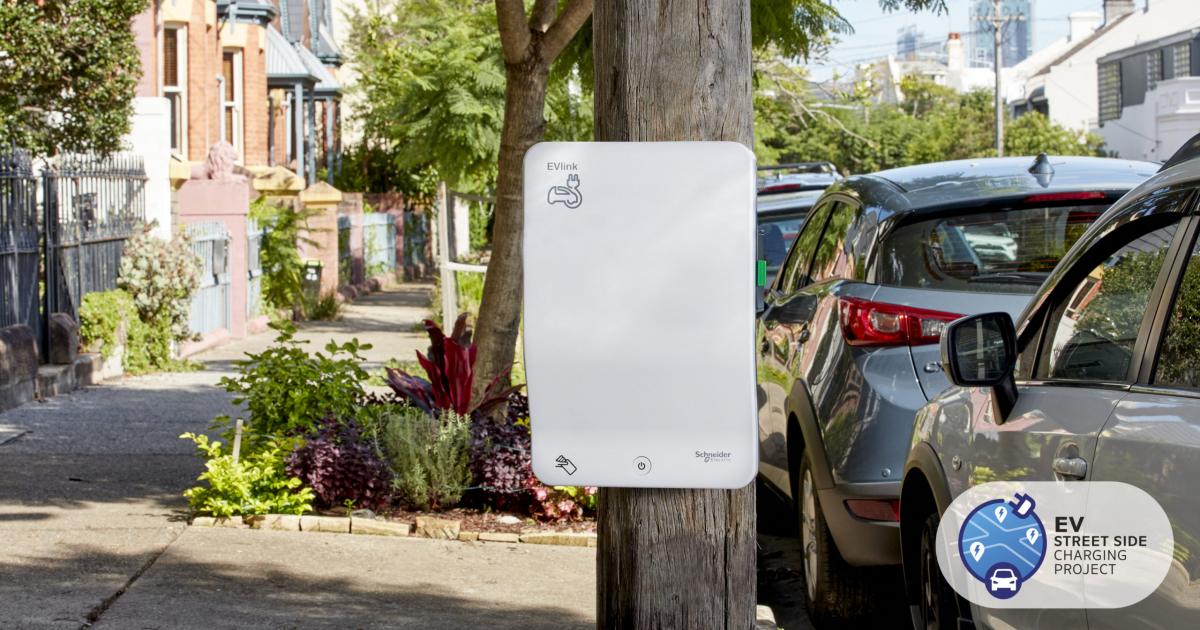
50 sites across nine local government areas in NSW are to have EV chargers mounted on power poles to service electric car owners who don’t have off-street parking.
There’s little doubt electric vehicles will really take off in Australia as prices of cars drop and availability improves. But around 25% of households don’t have access to off- street parking and therefore can’t (safely) charge an EV from home. Some EV owners in such a predicament have been resourceful; stringing extension cords from their homes to the street – but this practice is a serious electrical safety and trip hazard.
Something plentiful in many parts of Australia are power poles. While underground power is becoming more common, there are still around 7 million power poles across the country, and many of these are in heavily populated areas located adjacent to a road.
The Australian Renewable Energy Agency (ARENA) announced yesterday it will be providing an $871,000 grant to Intellihub for the deployment of 50 electric vehicle chargers supplied by Schneider Electric to be installed on power poles.
“Power poles line most of our public streets and that presents an opportunity for the EV charging market,” said Intellihub CEO Wes Ballantine. “They’re an accessible, safe, and practical option for EV charging.”
According to Intellihub, there’s potential for 190,000 EV chargers to be connected to street- side power poles across Australia; each capable of servicing 10 households without access to off-street parking.
A First For Australia, But Not The First
A number of potential challenges spring to mind such as vandalism1 and equity of access. But while an Australian-first, power pole EV chargers have already been deployed beyond our shores in the USA, Canada and Europe; providing examples to learn from. On a related note, there have also been trials of EV charger “smart” street- light poles in Australia – in the Sydney suburbs of Blacktown and Canada Bay.
The local power pole trial will provide insights and solutions to any regulatory barriers and create a commercial model for Australian conditions.
As well as Intellihub and Schneider Electric, other members of the consortium involved in the project and their roles are:
- Withywindle – consultants
- EVSE – managing the charging service.
- AutoGrid – to manage related virtual power plant and distributed energy solutions.
- Origin Energy – providing 100% GreenPower for the trial. This is a great feature given NSW’s energy mix is still heavy on fossil fuels.
The councils participating in the project are:
- Waverley
- Woollahra
- Randwick
- Lake Macquarie
- Ryde
- Singleton
- Parramatta
- Northern Beaches
- Inner West local
EV Charging As A Solar Sponge
The popularity of solar power in Australia is such that in some places it’s causing headaches in the management of local electricity networks. It’s a case of too much of a good thing (for now), but only at certain times of the day. This is where electric vehicles may be of help.
Commenting on the trial, Withywindle’s David Anstee said as well as indicating charging habits of Australian EV owners across different locations and with different incentives, it will provide insights into how to use electric vehicles to soak up excess rooftop solar power during periods of high exports.
More information on the $2.04m project can be found here. The trial is expected to kick off in December this year.
Related: Public EV Charging Locations Across Australia
Footnotes
- Vandalism could perhaps be dealt with at the time of offence with a death sentence delivered by the charger. Or is that too harsh? ↩

 RSS - Posts
RSS - Posts



An interesting notion, but only possible where there’s powerpoles – a lot of streets don’t have them!
It also requires that the poles actually have energy available. California, which wants to be 100% EV sales by 2035, is encouraging residents to defer recharging their EVs, and not use heavy appliances, 4-9 p.m up until Labor Day – Monday next week, lest blackouts ensue. If the state is struggling to provide power now, how’s it going to cope when the population is forced to transition to pure EVs, or walk?
George Kaplan,
“…only possible where there’s powerpoles – a lot of streets don’t have them!”
Instead, there are usually streetlight poles. Where do you think the electricity comes from to operate those lights, George?
“It also requires that the poles actually have energy available.”
Like ICEVs needing fuels to be available & affordable to operate, eh George? ?
It looks like Australian retail diesel fuel prices are on the way up again.
NSW state average diesel prices peaked at AU$2.29/litre on Jul 7, fell to $1.95/litre on Aug 24-25, & now up to $2.02/litre today (Sep 2).
https://fuelprice.io/nsw/?fuel_type=diesel
Victoria, Queensland & South Australia are averaging at $2.05/litre
Tasmania is at $2.09/litre.
ACT is at $2.11/litre.
NT is at $2.43/litre.
WA is at $1.92/litre.
After Sep 28, Australian retail fuel prices will likely rise 22.1 cents per litre as the temporary fuel excise cut ends.
Rising diesel fuel prices puts the prices of nearly everything up.
There must be a better way – Janus Electric says there is at: https://www.januselectric.com.au/
Just curious about where the statistic that 25% of households don’t have off-street parking came from. I’ve been looking for this kind of stat for a while. Does the source also provide any further breakdown, such as by State or LGA?